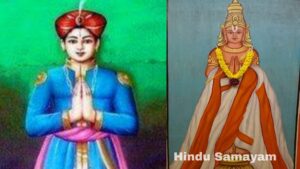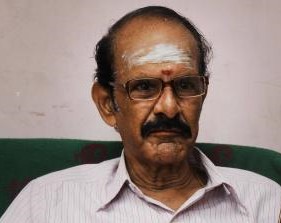 Thiru.Kulasekhara Azhwar was born in Thiruvanjikkulam in the present-day Kerala state of India, which was a completely Hindu land in ancient Bharat as was the entire land of Bharat. He was born in the Tamil Hindu month of Maasi in the punarpoosam star of Bhagwan Shri.Ram. Thiru.Kulasekhara Azhwar was born as a prince in the royal and mighty ruling Chera family. His father was Thidaviradhan, a great Bhagawan Narayana Bhakt. He grew up to be the mighty Chera King, Thiru. Kulasekharan.
Thiru.Kulasekhara Azhwar was born in Thiruvanjikkulam in the present-day Kerala state of India, which was a completely Hindu land in ancient Bharat as was the entire land of Bharat. He was born in the Tamil Hindu month of Maasi in the punarpoosam star of Bhagwan Shri.Ram. Thiru.Kulasekhara Azhwar was born as a prince in the royal and mighty ruling Chera family. His father was Thidaviradhan, a great Bhagawan Narayana Bhakt. He grew up to be the mighty Chera King, Thiru. Kulasekharan.
Kulasekhara Azhwar learnt many languages in his youth including Tamil and Sanskrit. He also learnt many arts and skills including horse riding and sword fighting. He defeated the mighty Chola kings and Pandya kings after he became king. He got married to a Pandya king’s daughter. Kulasekara Azhwar got disillusioned with war and developed great bhakti towards Bhagwan Ram. He loved listening to stories about Bhagwan Rama. Shri. Kulasekhara Azhwar turned very spiritual. His Vishnu bhakti or bhakti towards Lord Vishnu’s incarnation especially the Lord Ram increased day by day. He began to listen to long discourses about Lord Ram and performed a certain miracle, too.
Kulasekekhara Azhwar wrote many poems imagining the childhood of Prabhu Shri. Ram. Kulasekara Azhwar realised that spirituality and closeness to God is more important than all the wealth in the world. He was a greatly charitable king like his father. He donated to the poor and to Vishnu bhaktas.
One even observes some closeness between the Lord Buddha and Shri.Kulasekhara Azhwar. Both were Kings turned spiritual people. While the Lord Buddha attained Godliness through meditation or Raj Yoga, Kulasekhara Azhwar attained Godliness through Bhakti yoga or Path of Devotion.
Thus, Kulasekhara Azhwar was a great Bhagwan Vishnu bhakt. Kulasekhara Azhwar wrote ‘Mukunda Mala’ in Sanskrit consisting around 40 verses. The ‘Mukunda Mala’ describes the misery of a soul trapped in this world and appeals to Bhagwan Krishna as a means of salvation. He also contributed 105 verses to Nalaayiram Divya Prabhandham or 4000 verses praising Lord Vishnu by the 12 Azhwars. The 105 verses are known as Perumal Thirumozhi. The Perumal Thirumozhi are verses in praise of Bhagwan Shri.Ram. The Tirukkulasekharapuram temple in Kodunganallur was founded by Kulasekhara Azhwar. Thus, Kulasekhara Azhwar was many persons in one – a bhakti theologian, a great king and a devotional poet. Thus, he was the author of two great compositions – ‘Perumal Thirumozhi’ in Tamil and ‘Mukunda Mala’ in Sanskrit.
One of the outstanding abilities of Thiru.Kulasekhara Azhwar was his ability to take Lord Shri Ram’s pain as his own. He would feel the pain of Lord Ram as his own whenever he listened to the story of Ramayana. His devotion to Lord Ram and Sita Devi was unquestionable.
In one poem, Kulasekhara Azhwar identifies himself with Devaki, the real mother of Krishna. In another place, he identifies himself with a Gopika in love with Bhagwan Krishna.
After being king for many years, Kulasekhara Azhwar resigned from the position of king and retired to Srirangam in present day Tamilnadu. He got his daughter married to the Lord of the Srirangam temple. There is a shrine dedicated to Kulasekhara Azhwar’s daughter in Srirangam temple. He visited many holy places and finally settled in Brahmadesam near Tirukkurukur, which is the birth place of Nammazhwar.
Kulasekhara Azhwar is considered to be the incarnation of the Kausthubha Mani that adorns Sriman Narayana’s chest.
Kulasekhara Azhwar is sometimes also identified with Kulasekhara Varma, a medieval dramatist from the Chera Royal Family. The art form of Kudiyattam is associated with Kulasekhara Varma.
By
Dr.S. Padmapriya, Chennai
Author

